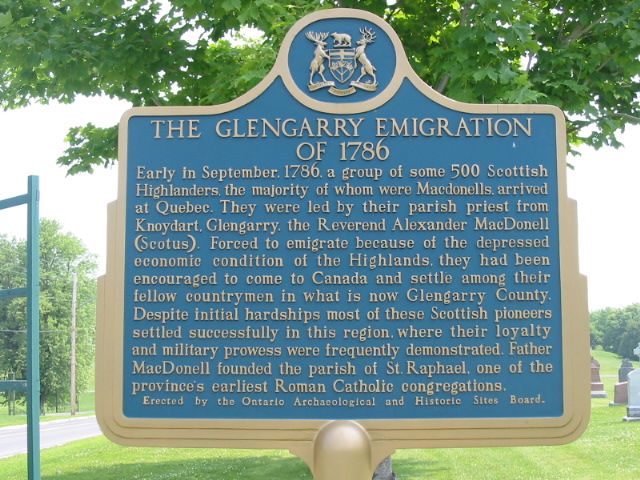Discover Ontario's history as told through its plaques
2004 - Now in our 13th Year - 2017
To see what's new on this site, you can visit the Home Page
Looking at this page on a smartphone?
For best viewing, hold your phone
in Landscape mode (Horizontal)
Glengarry Emigration of 1786

Photo by Alan L Brown - Posted June, 2005

Photo by contributor Wayne Adam - Posted December, 2009
Plaque Location
The United Counties of Stormont, Dundas and Glengarry
The Township of South Glengarry
In St. Raphaels, in a cemetery
adjacent to St. Raphael's Church Ruins
Coordinates: N 45 12.728 W 74 35.812 |
 |
Plaque Text
Early in September, 1786, a group of some 500 Scottish Highlanders, the majority of whom were Macdonells, arrived at Quebec. They were led by their parish priest from Knoydart, Glengarry, the Reverend Alexander MacDonell (Scotus). Forced to emigrate because of the depressed economic conditions of the Highlands, they had been encouraged to come to Canada and settle among their fellow countrymen in what is now Glengarry County. Despite initial hardships most of these Scottish pioneers settled successfully in this region, where their loyalty and military prowess were frequently demonstrated. Father MacDonell founded the parish of St. Raphael, one of the province's earliest Roman Catholic congregations.
Another plaque at this location
Parish of St. Raphael
Other plaques in St. Raphaels
Bishop Alexander Macdonell 1762-1840
The College of Iona
John Sandfield Macdonald 1812-1872
St. Raphael's Ruins
Related Ontario plaques
Bishop Alexander Macdonell 1762-1840
The Glengarry Fencibles
More
Information
More
Assorted Events
Here are the visitors' comments for this page.
> Posted March 23, 2013
Very interesting site. May I make one point - the plaque which says that the 1786 Glengarry emigrants from the Highlands were "forced to emigrate because of the depressed economic conditions of the Highlands" is not accurate. These Highlanders had to leave their own land because of the clearances (when they were evicted to make their farms into sheep ranches), accompanied by extreme increases of rent (some rents demanded were now ten times as much in a year or two). So far as the chiefs-turned-landlords of the Highlands were concerned, this was an enormous bonanza - very far from being a "depression".
I was actually born in Canada (Saskatchewan) but brought up in England; and I have written "The Scottish Highland Clearances", which will be published this year.
Alwyn Edgar
Here's where you can sent me a comment for this page.
Note: Your email address will be posted at the end of your comment so others can respond to you unless you request otherwise.
Note: Comments are moderated. Yours will appear on this page within 24 hours (usually much sooner).
Note: As soon as I have posted your comment, a reply to your email will be sent informing you.
To send me your comment, click .
Thanks
Alan L Brown
Webmaster
Note: If you wish to send me a personal email, click .